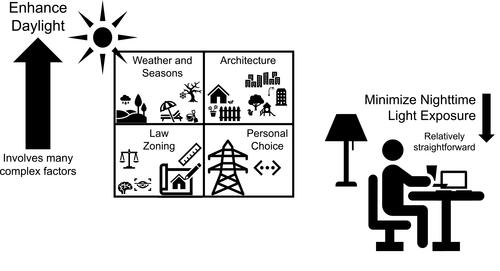Figures & data
Figure 1 A basic social-ecological model for circadian lighting. Maximizing daylight exposure might be more physiologically relevant for improving sleep-wake rhythms and sleep quality than minimizing nighttime light exposure. However, enhancing access to daylight involves many complex factors. Beyond obvious ones such as weather and time of year, daylight exposure depends on architecture and the physical environment where a person resides. The distribution of daylight is affected by the availability of surrounding vegetation and the layout of urban centers, especially as it pertains to the height and spacing between tall buildings. Windows and design features that facilitate entry of daylight (eg, atria) are not primary considerations in the floor plans for most public spaces. Broad adoption of solar rights that mandate minimal standards of daylight exposure for building occupants and inform the layout of new construction can augment a person’s sleep/circadian health. Personal choices about how a person spends their time, whether indoors with electric lighting or outdoors during the day, can add or subtract from these policy efforts.

